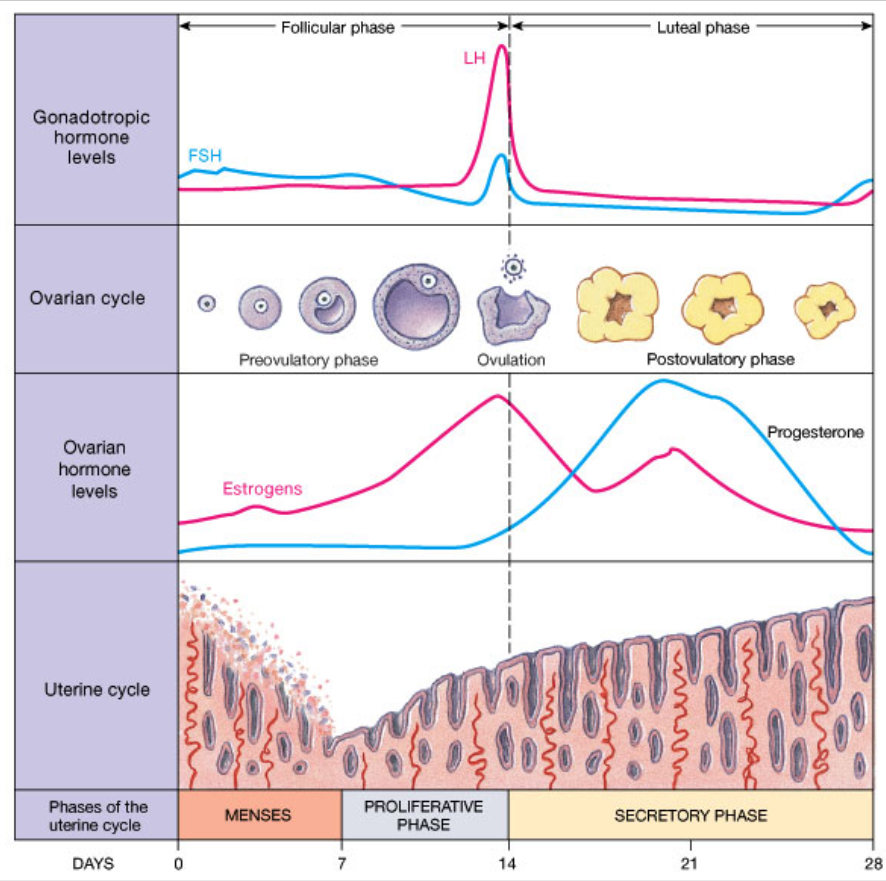PDH - Female Reproductive System
Menstrual Cycle
- menstruation
- follicular phase
- ovulation
- luteal phase
- “menstrual cycle” is the time from 1 period to another
- occurs monthly
- average cycle is 28 days
- can get it between 8-16 years
Different Phases
Menstruation (1)
- day 1- 8
- aka period
- uterus sheds its lining
- 40mL of blood
- occurs for 5-7 days
- blood and other tissue leave the body
- ALL hormones are LOW
Follicular Phase
- day 1-14
- 1st part of cycle
- pituitary gland in brain releases a hormone
- this stimulates the production of follicles
- usually only one follicle will mature into an egg
- FSH and LH involved
Ovulation (3)
- day 14
- ovary releases egg
- where egg drops
- FSH, oestrogen and LH (luteinizing hormone)
Luteal Phase (4)
- day 15-28
- 2nd part of cycle
- where the uterus prepares for pregnancy
- thickening of the uterine lining
- Progesterone and oestrogen

PMS (pre-menstrual syndrome)
Not all girls have PMS. It usually starts a week before your period and goes away after the first couple of days of bleeding. Some symptoms:
- bloating
- breasts swollen and sore
- muscle pain
- moody
- crying
- tired, weak
- hungry, cravings
- mixed up thinking
- stomach ache
- pimples
- diarrhea and constipation
Definitions
Uterus: part inside body where baby grows
Inner lining of the uterus: supports and nourishes baby. if there is no baby, it sheds during a period
Vagina: blood and other tissue leave the body through the vagina
Ovaries: 1 on each side, holds eggs (female sex organs) - produce estrogen and progesterone
Fallopian tubes: lead from each ovary to the uterus
Vulva: outer part, two bumps
Mons pubis: fleshy area located above the top of the vaginal opening
Labia: two pairs of skin flaps
Clitoris: small sensory organ, in between the labia
Urethra: the tube that carries urine
Hymen: a very thin piece of skin like tissue
Menarche: girl’s first period
Egg names:
- Ovum: female sex cell (aka egg)
- Egg: released from ovaries, 1/10 the size of poppy seed, dissolves if not fertilized
- Zygote: fertilised egg
- Embryo: once fertilised egg splits and develops
- Fetus: approx 9 weeks after fertilisation
Endometriosis:
- when cells similar to the uterus lining forms in other parts of the body
- cells react to the menstrual cycle and also bleed
- but there is no way for the blood to leave the body so it causes (see below)
- important that you find out as early as possible so it can be managed
- estimated that 1 in 10 women have endometriosis
Causes:
- inflammation
- severe pain
- heavy or irregular periods